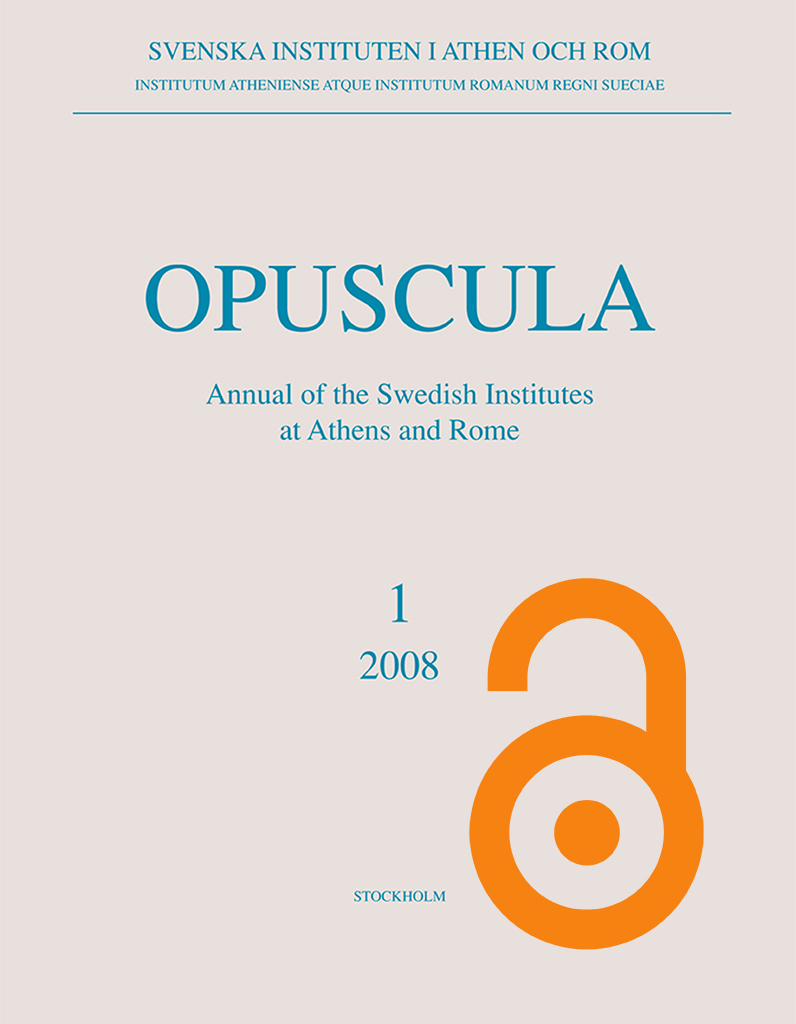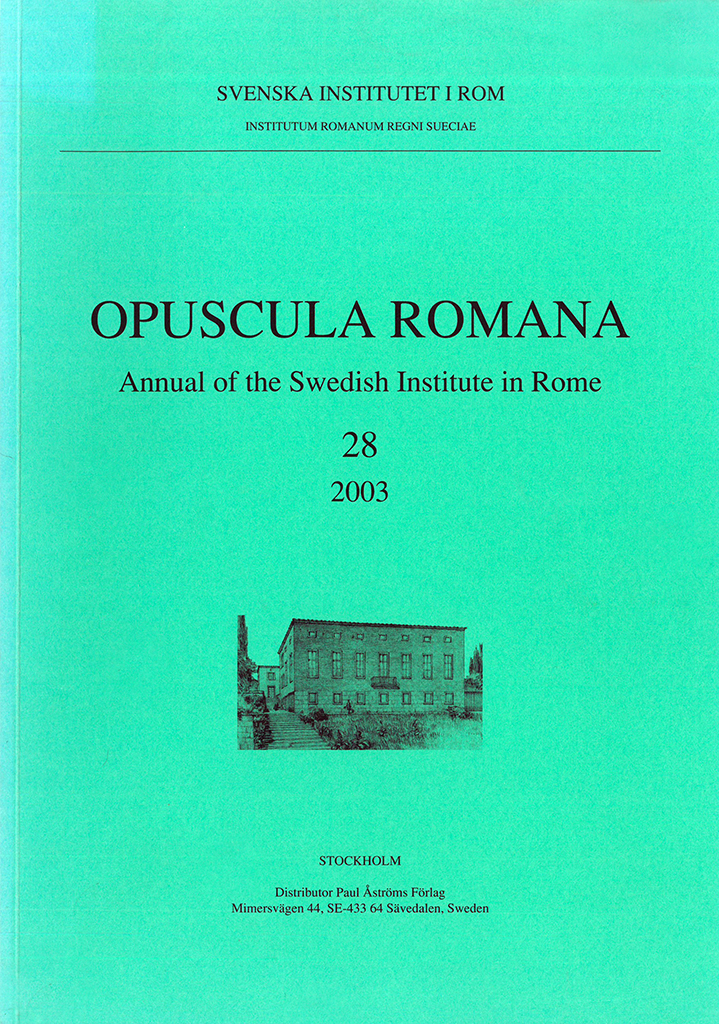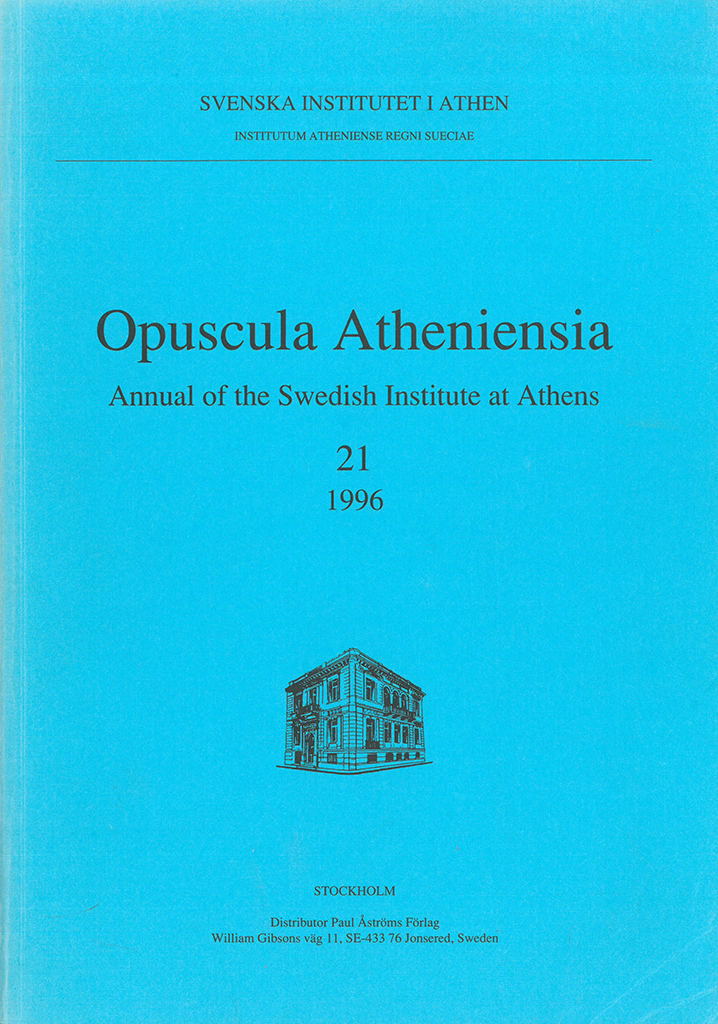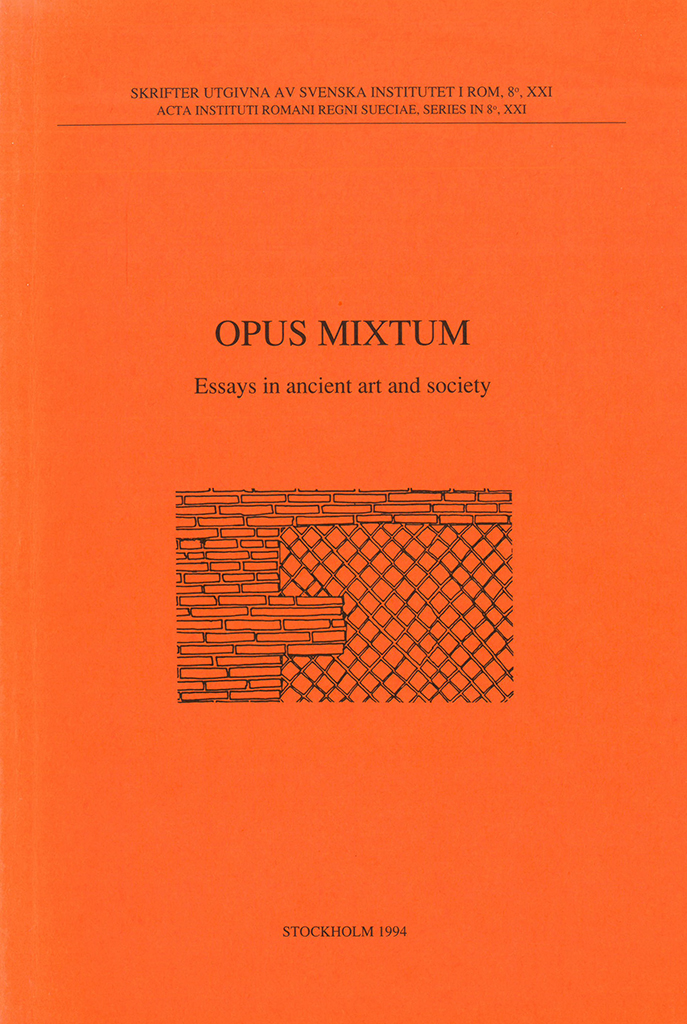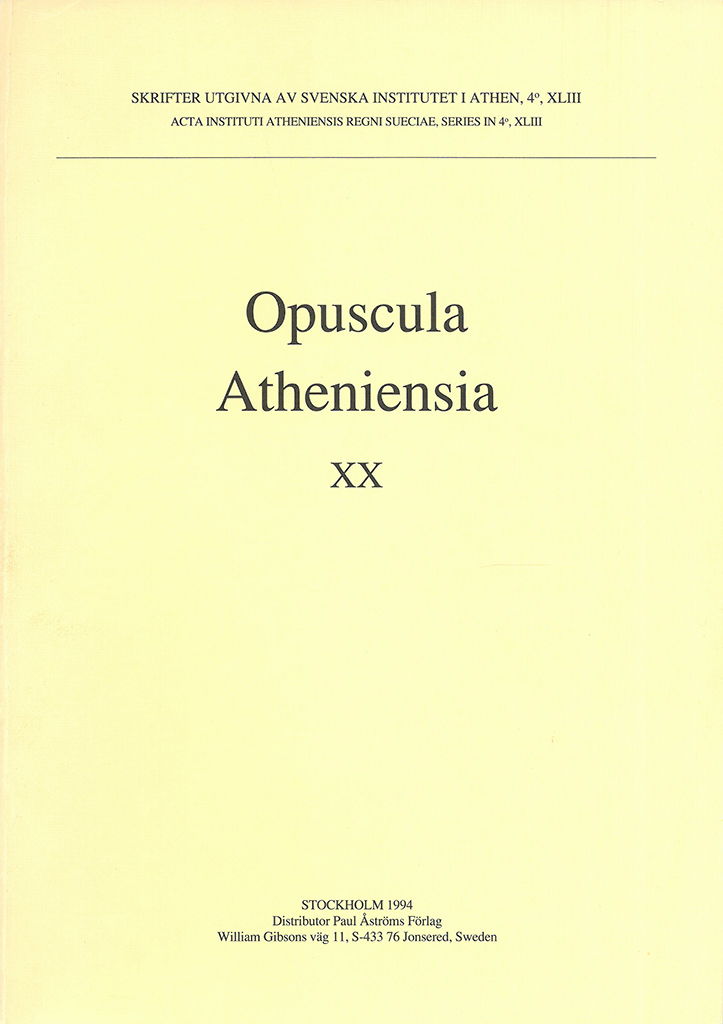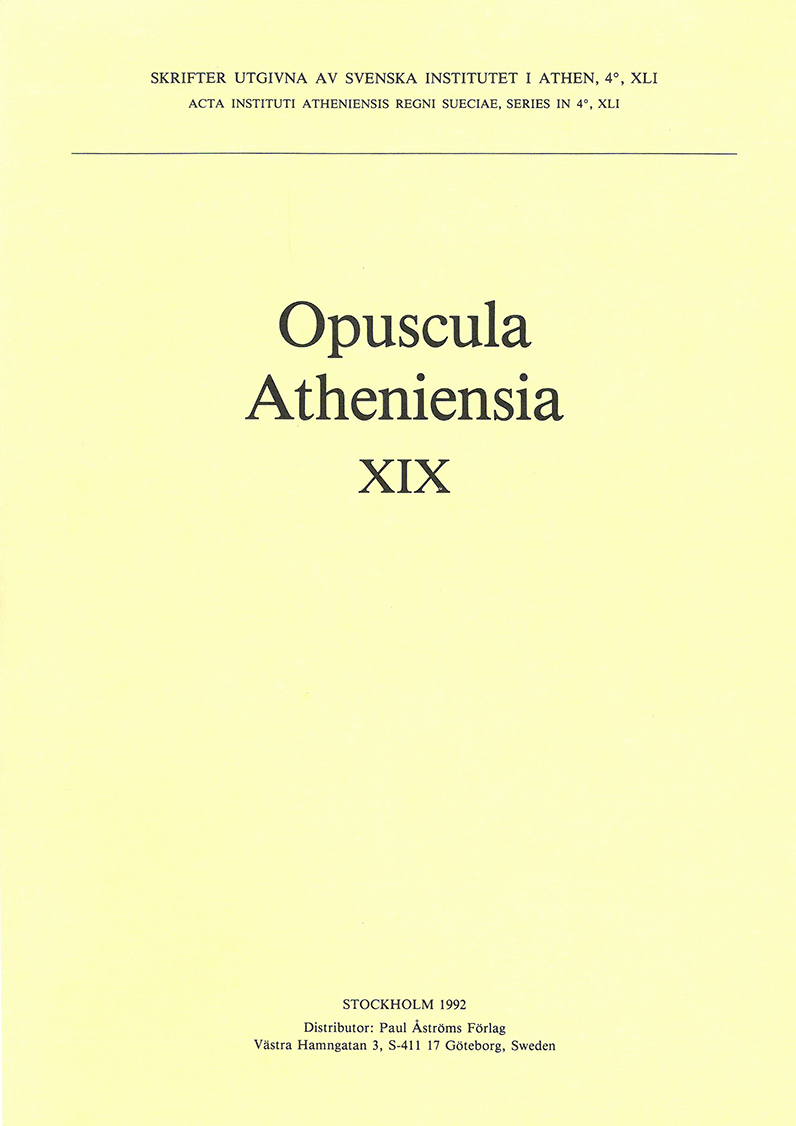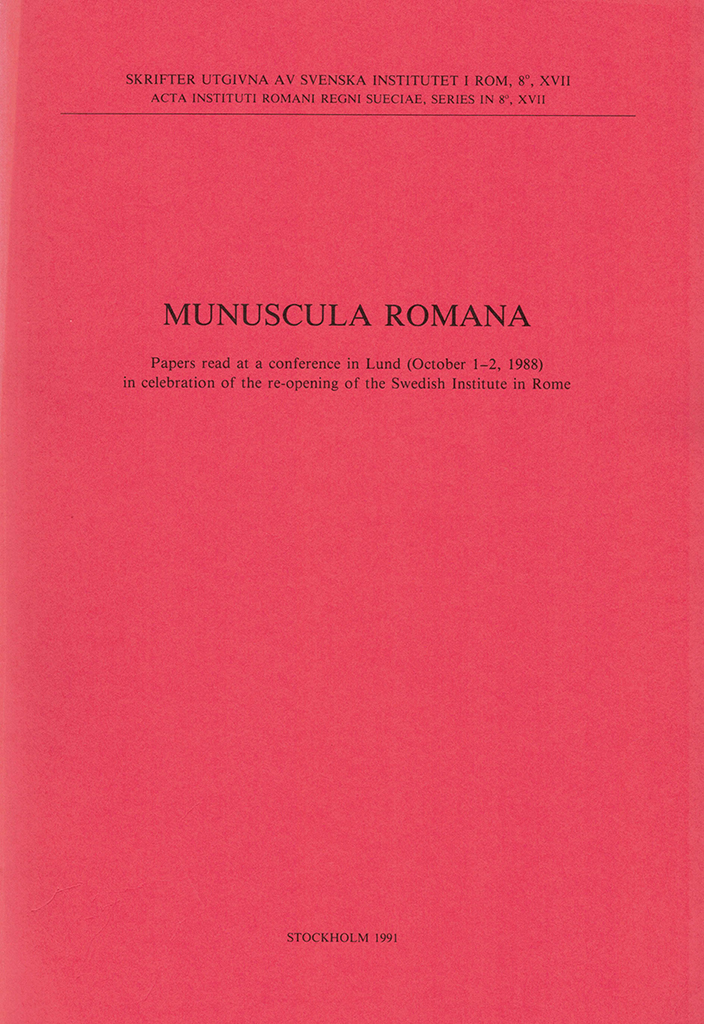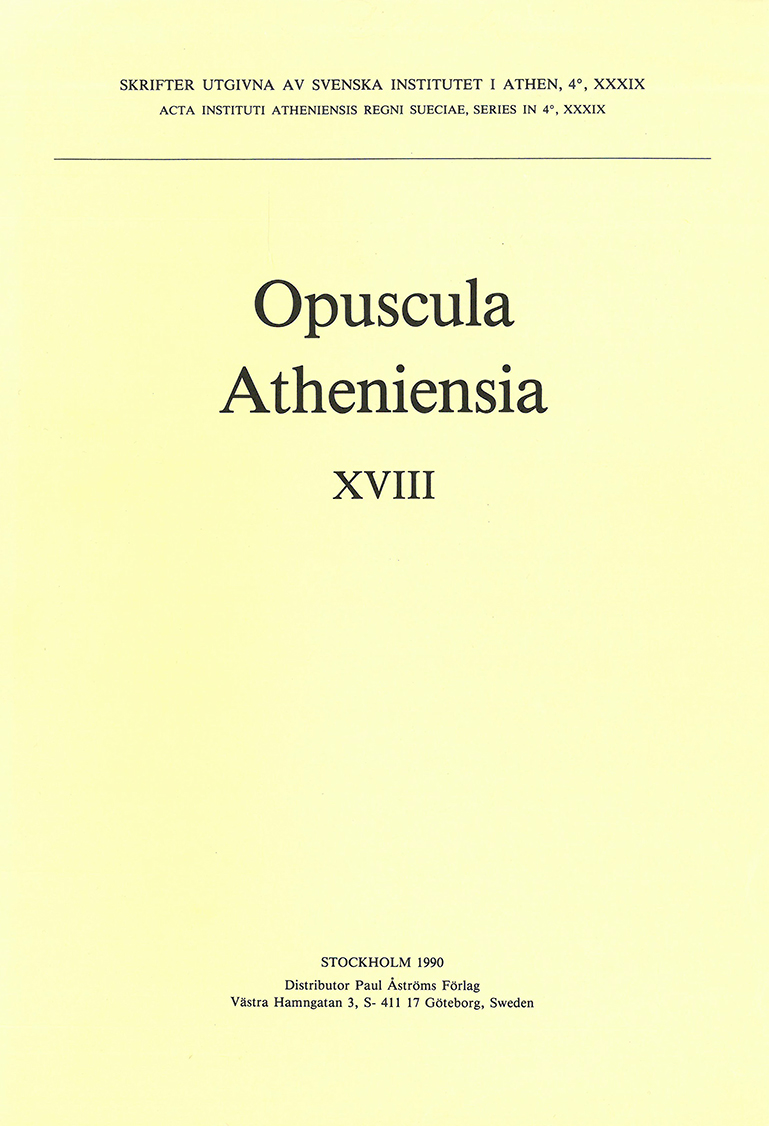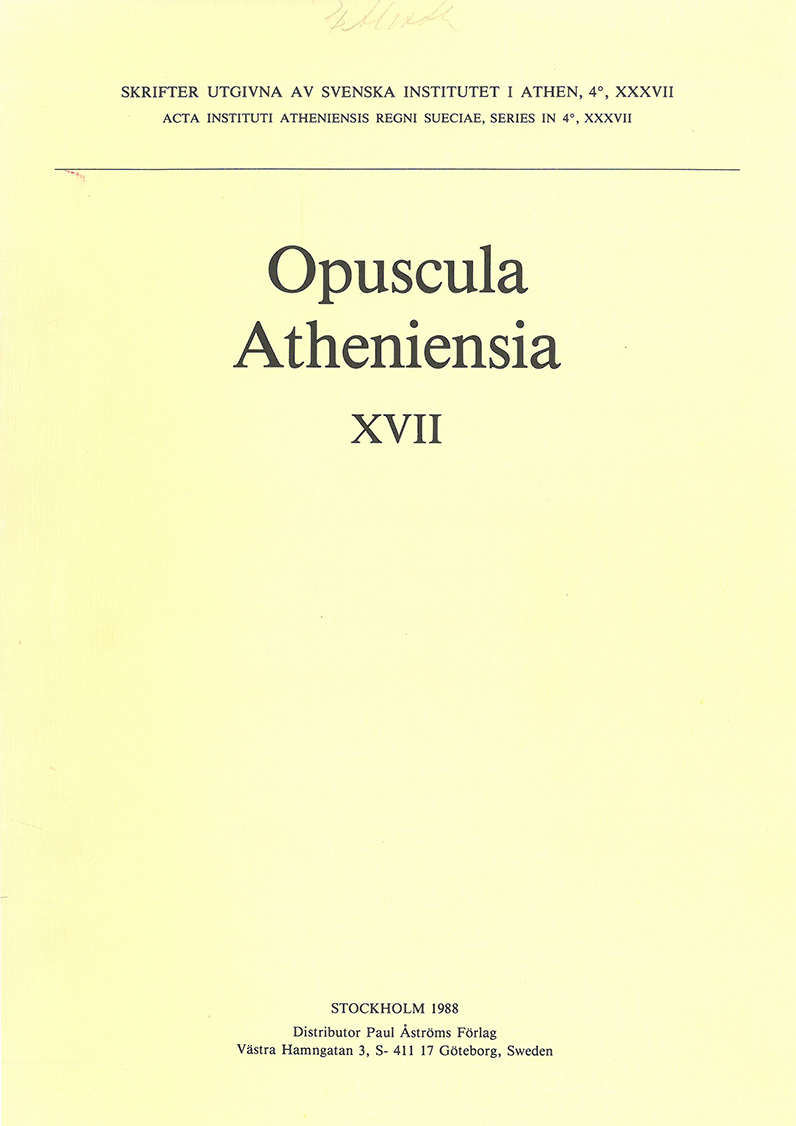Opuscula is published by the Swedish Institutes at Athens and Rome, with the aid of a grant from the Swedish Research Council. Distributed by Eddy.se AB. View journal at ERIH PLUS. All content available with open access. Cooking stands and braziers in Greek sanctuaries By Charlotte Scheffer Abstract The presence of dining-rooms in Greek sanctuaries shows that food was eaten and most likely also cooked on the premises. The study of both the preparation and the cooking of the food eaten in the sanctuaries would be too much, and this paper will therefore concentrate on the presence of cooking stands and braziers in Greek sanctuaries, their uses, and on other related means of carrying the pots. Cooking stands were meant to hold the cooking pots above the fire; they were open at the bottom and were placed in the fire or perhaps rather in the glowing embers of a fire. In Etruria, there were three types (types I–III): a cylindrical stand with a top plate with holes, a half-cylindrical stand with three supports attached to the inner side of the wall, and a barrel-like stand with a narrower top. Cooking braziers had, unlike the cooking stands, a closed bottom as…
Opuscula is published by the Swedish Institutes at Athens and Rome, with the aid of a grant from the Swedish Research Council. Distributed by Eddy.se AB. View journal at ERIH PLUS. Content available with open access. Opuscula. Annual of the Swedish Institutes at Athens and Rome 1, 2008 Contents ‘Front matter‘, 1–6 Katie Demakopoulou, Nicoletta Divari-Valakou, Monica Nilsson, Ann-Louise Schallin, with an appendix by Kalliopi Nikita, ‘Excavations in Midea 2006’, 7–30 https://doi.org/10.30549/opathrom-01-02 John K. Papadopoulos, ‘The Archaic wall of Athens. Reality or myth?’, 31–46 https://doi.org/10.30549/opathrom-01-03 Anton Bonnier, ‘Epineia kai limenes. The relationship between harbours and cities in ancient Greek texts’, 47–61 https://doi.org/10.30549/opathrom-01-04 Fabrizio Vistoli, ‘Una nuova acquisizione di ceramica “white-on red” dall’ager Veientanus’, 63–77 https://doi.org/10.30549/opathrom-01-05 Ola Wikander, ‘The religio-social message of the gold tablets of Pyrgi’, 79–84 https://doi.org/10.30549/opathrom-01-06 This contribution is only available in print. Milette Gaifmann, ‘Visualized rituals and dedicatory inscriptions on votive offerings to the Nymphs’, 85–103 https://doi.org/10.30549/opathrom-01-07 Gabriella Barbieri, ‘Materiali inediti da Sovana. Alcuni corredi funerari dalla necropoli di San Sebastiano’, 105–122 https://doi.org/10.30549/opathrom-01-08 This contribution is only available in print. Maria Gabriella Scapaticci, ‘Nuovi dati sul popolamento nella pianura di Tarquinia durante la romanizzazione. Il caso della località “Il Giglio”‘, 123–135 https://doi.org/10.30549/opathrom-01-09 Paavo Roos, ‘A forgotten tomb…
Published by the Swedish Institute of Classical Studies in Rome. Distributed by Astrom Editions. Opuscula Romana. Annual of the Swedish Institute in Rome 28, 2003 Contents Anne-Marie Leander Touati | Prologue to the Ninth Boëthius Lecture celebrating the 75th anniversary of the Swedish Institute in Rome (pp. 7-8) Antonio Manfredi | San Lorenzo in Lucina, Jean Le Jeune, Jean Jouffroy and the search for manuscripts in France during the papacy of Nicholas V (1447-1451) with a note by Maria Elena Bertoldi (pp. 9-34) Janne P. Ikäheimo | The ploughsoil assemblage of Zone 4a at Ficana (Monte Cugno) (pp. 35-45) Charlotte Scheffer | Dangerous driving: an Etruscan motif against the Greek and Roman background (pp. 47-72) Margareta Strandberg Olofsson | Four imported transport Amphorae from Acquarossa (pp. 73-83) Book reviews David Ridgway | J.R. Brandt & L. Karlsson (eds.), From huts to houses. Transformations of ancient societies. Proceedings of an International Seminar organized by the Norwegian and Swedish Institutes in Rome, 21-24 September 1997 (pp. 85-88) Örjan Wikander | B. Ginge, Excavations at Satricum (Borgo Le Ferriere 1907-1910: Northwest necropolis. Southwestsanctuary and Acropolis (pp. 88-89) Örjan Wikander | A.-M.Romeuf & J. Romeuf, Le quartier artisanal gallo-romain des Martres-de-Veyre (Puy-de-Dôme) (pp. 89-90)…
Published by the Swedish Institute at Athens. Distributed by Astrom Editions. Opuscula Atheniensia. Annual of the Swedish Institute at Athens 21, 1996 Contents Edmund F. Bloedow, ‘‘Olympian’ thoughts: Plutarch on Pericles’ Congress Decree’ Katie Demakopoulou, Nicoletta Divari-Valakou, Paul Åström & Gisela Walberg, ‘Excavations in Midea 1994’ Lola Eriksson, ‘The Greek perception of nature—an ideological strategy? Preliminary outline for a working hypothesis’ Jeannette Forsén, ‘Prehistoric Asea revisited’ Jeannette Forsén, Björn Forsén & Mika Lavento, ‘The Asea valley survey: a preliminary report of the 1994 season’ Göran Henriksson & Mary Blomberg, ‘Evidence for Minoan astronomical observations from the peak sanctuaries on Petsophas and Traostalos’ Elizabeth Kosmetatou, ‘Midea in the post-Bronze-Age period. A preliminary report’ Peter Liljenstolpe & Patric von Schmalensee, ‘The Roman stoa of Poleites at Labraynda. A report in its architecture with an appendix by Johan Flemberg’ Arto Penttinen, ‘Excavations on the Acropolis of Asine in 1990’ Charlotte Scheffer, ‘Return or no return. The so-called ephedrismos group and the Hephaisteion’ Berit Wells, Gunnel Ekroth & Kai Holmgren, ‘The Berbati Valley Project: the 1994 season’ Book reviews E. Schorfield, ‘A.-L. Schallin, Islands under influence. The Cyclades in the late Bronze Age and the nature of the Mycenaean presence’ Carole Gillis, ‘T.P. Hutchinson,…
Published by the Swedish Institute of Classical Studies in Rome. Distributed by Astrom Editions. Opus Mixtum. Essays in ancient art and society Edited by Eva Rystedt, Charlotte Scheffer and Charlotte Wikander Abstract Fifteen papers on various aspects of ancient art and society are gathered in this volume. They deal with the choice of moment depicted in the Parthenon frieze, the use of the Greek architectural orders in political propaganda, and the “programme” of the relief plaques from zone F at Acquarossa which is suggested to be celebrations connected to the ruler. The architectural layout of a well-temple in Sardinia is interpreted as an iconographic message of the cult of Tanit-Astarte. The significance of the horse in connection with death and the various types of female deities connected with horses in Archaic Greek religion are discussed, as well as the image of Artemis Ephesia and its connection with the mysteries of the goddess, the epithet Ambologera (“Delayer of old age”) attributed to Aphrodite, and the role of women in Roman religion. A white-ground lekythos by the Achilles Painter with the “mistress-and-maid” motif associated with music-making is analysed. A reconstruction of the Laocoon group, especially regarding the positions of the serpents is…
Published by the Swedish Institute at Athens. Distributed by Astrom Editions. Opuscula Atheniensia 20 Contents Articles Diane L. Bolger, ‘Engendering Cypriot archaeology: female roles and statuses before the Bronze Age’ Katie Demakopoulou, Nicolletta Divari-Valakou & Gisela Walberg, ‘Excavations and restoration work in Midea 1990–1992’ Björn Forsén, ‘Marmorne Gewichtsteine aus Thera’ David Frankel & Jennifer M. Webb, ‘Hobs and hearths in Bronze Age Cyprus’ Carole Gillis, ‘Binding evidence. Tin foil and organic binder on Aegean Late Bronze Age pottery’ Vassos Karageorghis, ‘Monkeys and bears in Cypriot art’ Jane F. Lloyd, ‘A clay triton shell in a private collection in New York’ Erik Østby, Jean-Marc Luce, Gullög C. Nordquist, Chiara Tarditi & Mary E. Voyatzis, ‘The sanctuary of Athena Elea at Tegea: first preliminary report (1990–1992)’ Jari Pakkanen, ‘Accuracy and proportional rules in Greek Doric temples’ Edgar Peltenburg, ‘Constructing authority: the Vounos enclosure model’ Claus Reinholdt, ‘”ΝΟΣΤΟΣ ΌΔΥΣΣΗΙ” oder Vita Humana? Zu einem Vasenbild des Schweinemalers in Cambridge’ Paavo Roos, ‘In search of ancient stadia and hippodromes in Anatolia’ Ilse Schoep, ‘”Home sweet home”. Some comments on the so-called house models from the prehellenic Aegean’ Eva Toivonen Skage, ‘Supplementary sherds from Ayos Jakovos Tomb 9, Dromos’ Eberhard Zangger, ‘The island of Asine:…
Published by the Swedish Institute at Athens. Distributed by Astrom Editions. Opuscula Atheniensia 19 Contents Carl Nylander, ‘Sture Brunnsåker, 1925–1978’, p. 9. Paul Åström, Katie Demakopoulou, Nicoletta Divari-Valakou & Peter M. Fischer, ‘Excavations in Midea, 1989–1990’, pp. 11–22. Gisela Walberg, ‘Excavations on the Lower Terraces at Midea’, pp. 23–39. Birgitta Bergquist, ‘A particular, Western Greek cult practice? The significance of stele-crowned, sacrificial deposits’, pp. 41–47. Mary Blomberg, ‘The meaning of Χελιδών in Hesiod’, pp. 49–57. Robin Hägg & Gullög C. Nordquist, ‘Excavations in the Levendis sector at Asine, 1989. A preliminary report with an appendix on the animal bones by Katrin Moberg’, pp. 59–68. Tullia Linders, ‘The Delian temple accounts: some observations’, pp. 69–73. Alexandros Mazarakis Ainian, ‘Nichoria in the south-western Peloponnese: Units VI-1 and IV-5 reconsidered’, pp. 75–84. Erik Østby, ‘Der dorische Tempel von Pherai’, pp. 85–113. Paul Rehak, ‘Minoan vessels with figure-eight shields: antecedents to the Knossos throneroom alabastra’, pp. 115–124. Eva Rystedt, ‘Notes on the rattle scenes on Attic Geometric pottery’, pp. 125–133. Berit Wells, ‘The walls of Asine’, pp. 135–142. Charlotte Wikander, ‘Pomp and circumstance. The procession of Ptolemaios II’, pp. 143–150. Örjan Wikander, ‘Archaic roof-tiles: the first (?) generation’, pp. 151–161. Miscellanea Åke Åkerström (†),…
Published by the Swedish Institute of Classical Studies in Rome. Distributed by Astrom Editions. Munuscula Romana. Papers read at a conference in Lund (October 1–2, 1988) in celebration of the re-opening of the Swedish Institute in Rome Edited by Anne-Marie Leander Touati, Eva Rystedt & Örjan Wikander. Preface In October 1988, the Swedish Institute in Rome was reopened after a period of renovation. From the point of view of Classical scholarship in Sweden, this reopening was an event that called for celebration: thus a symposium was held in Lund, on the initiative of the Department of Classical studies at the University, in collaboration with the South Swedish chapter of the Society of Friends of the Institute (October 1–2, 1988). The aim of the symposium was to give an idea of the current range of Swedish scholarship within the Italic and Roman spheres. This research is carried out in numerous disciplines—history (political, social, economic), epigraphy, numismatics, religion, art, etc.—and within broad chronological frames (from prehistory to Late Antiquity). Of the papers read at the symposium, most are presented here, in revised versions. Regrettably, four lectures which contributed to the wide range of subjects, do not appear: P.G. Gierow, ‘The Aeneas legend’;…
Published by the Swedish Institute at Athens. Distributed by Astrom Editions. Opuscula Atheniensia 18 Contents Articles Paul Åström, Katie Demakopoulou, Nicoletta Divari-Valakou, Peter M. Fischer & Gisela Walberg, ‘Excavations in Midea 1987’, 9–22. Birgitta Bergquist, ‘Primary or secondary temple function: the case of Halieis’, 23–37. Danali-Giole, ‘Ikonographische Beobachtungen zu drei Mythologischen Themen: Pentheus, Phineus, Prometheus’, 39–44. Søren Dietz & Nicoletta Divari-Valakou, ‘A Middle Helladic III/Late Helladic I grave group from Myloi in the Argolid (Oikopedon Manti)’, 45–62. Carole S. Gillis, ‘Statistical analyses and conical cups. A preliminary report from Akrotiri, Thera’, 63–93. Robin Hägg, ‘The Cretan hut-models’, 95–107. Bernard Knapp, ‘Copper production and Mediterranean trade: the view from Cyprus’, 109–116. A.A.D. Peatfield, ‘Minoan peak sanctuaries: history and society’, 117–131. Francis Piejko, ‘To the inscriptions of Labraunda’, 133–156. Gery de Pierpont, ‘Aegean jewellery: a new approach to a typology. Application on gold and silver Minoan jewellery (2700–1450)’, 157–165. Eva Rystedt, ‘On distinguishing hands in Mycenaean pictorial vase-painting’, 167–176. Eva Rystedt, ‘Die Wagenfriese der attischen geometrischen Keramik und die Frage ihrer Ablesung. Vorläufige Bemerkungen anlässlich einer Vase im Louvre’, 177–183. Charlotte Scheffer, ‘“Domus Regiae”—a Greek tradition?’, 185–191. Peter Warren, ‘Of baetyls’, 193–206. Berit Wells, Curtis Runnels & Eberhard Zangger, ‘The Berbati-Limnes archaeological…
Published by the Swedish Institute at Athens. Distributed by Astrom Editions. Opuscula Atheniensia 17 Contents Articles Paul Åström, Katie Demakopoulou & Gisela Walberg, ‘Excavations in Midea 1985’, pp. 7–11. Valerie Cook, ‘Cyprus and the outside world during the transition from the Bronze Age to the Iron Age’, pp. 13–32. Kåre Fagerström, ‘Fnds, function and plan: a contribution to the interpretation of Iron Age Nichoria in Messenia’, pp. 33–50. Arne Furumark (†), ‘Linear A and Minoan religion’, pp. 51–90. Heinz-Eberhard Giesecke, ‘Kretische Schurze’, pp. 91–98. Robin Hägg, ‘The last ceremony in the Throne Room at Knossos’, pp. 99–105. Pontus Hellström, ‘The planned function of the Mnesiklean Propylaia’, pp. 107–121. Bente Kiilerich, ‘Bluebeard—a snake-tailed Geryon?’, pp. 123–136. Nanno Marinatos, ‘The “African” of Thera reconsidered’, pp. 137–141. Susana Sjödin, ‘Bronze Age pottery sherds from Cyprus. Further supplementary material from Kalopsidha trench 9’, pp. 143–165. Christiane Sourvinou-Inwood, ‘”Myth” and history: on Herodotus III.48 and 50–53’, pp. 167–182. Colette Verlinden, ‘Réflexions sur la function et la production des figurines anthropomorphes Minoennes en bronze’, pp. 183–189. Anna Wærn-Sperber, ‘Mössbauer spectroscopy and quantitative chemical analyses of Early Cypriote black-topped pottery. A preliminary investigation’, pp. 191–197. Gisela Walberg, ‘Was Evans right? Further notes on Middle Minoan chronology’, pp….


